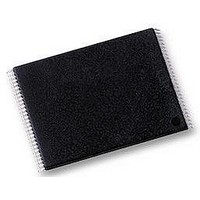NANDO1GW3B2CN6 NUMONYX, NANDO1GW3B2CN6 Datasheet - Page 30

NANDO1GW3B2CN6
Manufacturer Part Number
NANDO1GW3B2CN6
Description
IC, FLASH, 1GB, 25µS, TSOP-48
Manufacturer
NUMONYX
Datasheet
1.NANDO1GW3B2CN6.pdf
(60 pages)
Specifications of NANDO1GW3B2CN6
Memory Type
FLASH
Memory Size
1GB
Access Time
25µS
Supply Voltage Range
2.7V TO 3.6V
Memory Case Style
TSOP
No. Of Pins
48
Operating Temperature Range
-40°C TO +85°C
Voltage, Vcc
3.3V
Memory Configuration
128M X 8
Rohs Compliant
Yes
Device operations
6.8
6.8.1
6.8.2
6.8.3
30/60
Read status register
The device contains a status register which provides information on the current or previous
program or erase operation. The various bits in the status register convey information and
errors on the operation.
The status register is read by issuing the Read Status Register command. The status
register information is present on the output data bus (I/O0-I/O7) on the falling edge of Chip
Enable or Read Enable, whichever occurs last. When several memories are connected in a
system, the use of Chip Enable and Read Enable signals allows the system to poll each
device separately, even when the Ready/Busy pins are common-wired. It is not necessary to
toggle the Chip Enable or Read Enable signals to update the contents of the status register.
After the Read Status Register command has been issued, the device remains in read
status register mode until another command is issued. Therefore if a Read Status Register
command is issued during a random read cycle a new Read command must be issued to
continue with a page read operation.
The Status Register bits are summarized in
in conjunction with the following text descriptions.
Write protection bit (SR7)
The write protection bit can be used to identify if the device is protected or not. If the write
protection bit is set to ‘1’ the device is not protected and program or erase operations are
allowed. If the write protection bit is set to ‘0’ the device is protected and program or erase
operations are not allowed.
P/E/R controller and cache ready/busy bit (SR6)
Status register bit SR6 has two different functions depending on the current operation.
During cache program operations SR6 acts as a cache program ready/busy bit, which
indicates whether the cache register is ready to accept new data. When SR6 is set to '0', the
cache register is busy and when SR6 is set to '1', the cache register is ready to accept new
data.
During all other operations SR6 acts as a P/E/R controller bit, which indicates whether the
P/E/R controller is active or inactive. When the P/E/R controller bit is set to ‘0’, the P/E/R
controller is active (device is busy); when the bit is set to ‘1’, the P/E/R controller is inactive
(device is ready).
P/E/R controller bit (SR5)
The program/erase/read controller bit indicates whether the P/E/R controller is active or
inactive. When the P/E/R controller bit is set to ‘0’, the P/E/R controller is active (device is
busy); when the bit is set to ‘1’, the P/E/R controller is inactive (device is ready).
Table 13: Status register
NAND01G-B2B, NAND02G-B2C
bits,. Refer to
Table 13











